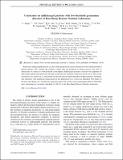Constraints on millicharged particles with low-threshold germanium detectors at Kuo-Sheng Reactor Neutrino Laboratory
Author(s)
Singh, L.; Chen, J. W.; Chi, H. C.; Liu, C.-P.; Pandey, M. K.; Wong, H. T.; Wu, C. P.; Agartioglu, M.; Deniz, M.; Li, H. B.; Lin, S. T.; Sharma, V.; Singh, M. K.; Singh, V.; Yue, Q.; ... Show more Show less
DownloadPhysRevD.99.032009.pdf (654.8Kb)
PUBLISHER_CC
Publisher with Creative Commons License
Creative Commons Attribution
Terms of use
Metadata
Show full item recordAbstract
Relativistic millicharged particles (χ[subscript q]) have been proposed in various extensions to the standard model of particle physics. We consider the scenarios where they are produced at nuclear reactor core and via interactions of cosmic rays with the Earth’s atmosphere. Millicharged particles could also be candidates for dark matter and become relativistic through acceleration by supernova explosion shock waves. The atomic ionization cross section of χ[subscript q] with matter are derived with the equivalent photon approximation. Smoking-gun signatures with significant enhancement in the differential cross section are identified. New limits on the mass and charge of χ[subscript q] are derived, using data taken with a point-contact germanium detector with 500 g mass functioning at an energy threshold of 300 eV at the Kuo-Sheng Reactor Neutrino Laboratory.
Date issued
2019-02Department
Massachusetts Institute of Technology. Center for Theoretical Physics; Massachusetts Institute of Technology. Department of PhysicsJournal
Physical Review D
Publisher
American Physical Society
Citation
Singh, L. et al. "Constraints on millicharged particles with low-threshold germanium detectors at Kuo-Sheng Reactor Neutrino Laboratory." Physical Review D 99, 3 (February 2019): 032009
Version: Final published version
ISSN
2470-0010
2470-0029